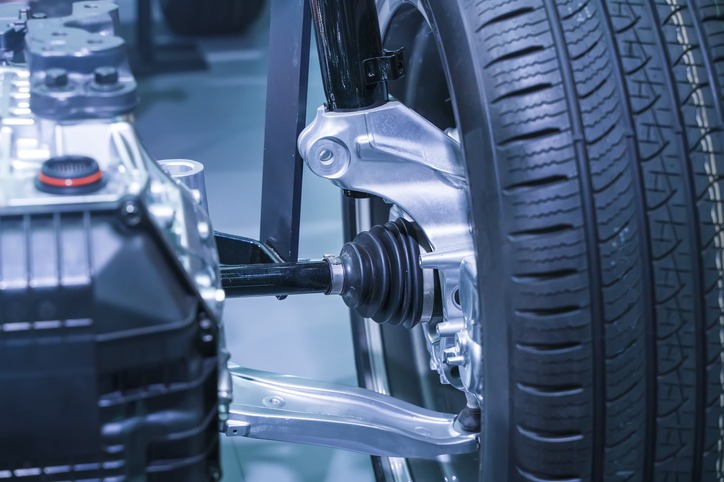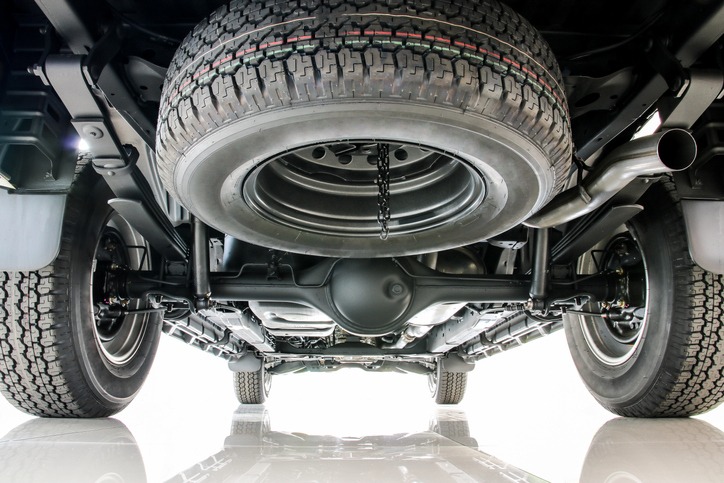A car comprises many moving parts that all work in unison. These parts, like an orchestra, come together at the perfect time to make everything work. As a result, you can drive without thinking about your car’s mechanics or how cars work.
The car axle is the one part that essentially keeps your car moving. Continue reading to find out what an axle is, how many axles a vehicle has, and everything else you need to know.
What Is a Car Axle?
An axle is a steel shaft or rod that rotates the wheels and supports the weight of a vehicle. The car axle connects the tires by shifting power from the transmission to the wheels, letting the vehicle move forward.
So, if you’ve ever wondered how your car’s engine produces the torque necessary to turn the wheels, thank the car axles! Every car requires these to function properly because they transmit the power that turns the wheels.
How Many Axles Does a Vehicle Have?
The vehicle type determines the number of axles in a car. Most automobiles have two axles that rotate the wheels. Larger vehicles with more wheels and passengers may have more axles.
It’s simple to understand how many axles your car or other vehicle has. Look at a car from the side and count the number of pairs of tires. Most automobiles have four or two sets of tires, one in the back and one in the front. Two axles are equal to two sets of tires.
Axle Types in Automobiles: Factors to Consider
Several factors influence the type of axle required by a vehicle. The amount of force produced, for example, and the technical requirements all play a role in determining the axle type.
Some vehicles have axles that are pre-designed in standard sizes. Others have axles that are tailored to the car’s specifications and needs. Customized axles work best for cars because they provide more personalized leverage over the wheels. These axles can fine-tune the torque and speed of the wheels.
Two Basic Types of Axle
There are two kinds of automobile axles. The first is known as the drive axle, linked to the driveshaft. The driveshaft is essentially a rod that extends into the transmission and connects to the engine. The engine then assists in turning the axle.
The other type is the dead axle, which is completely disconnected from the engine. It only turns when the car is in motion, prompted by the drive axle. Your vehicle has dead axles to help support the vehicle’s weight.
Other Common Axle Types
Axles are classified into three types:
- Front Axle: Positioned in the vehicle’s front, this axle is in charge of steering and processing shocks from the road’s uneven surface. They are made up of four major components: the beam, the track rod, the swivel pin, and the stub axle. Front axles must be as durable as possible, so they are typically made of nickel steel or carbon steel.
- Rear Axle: This axle is accountable for implementing power to the driving wheels. It is divided into two halves, identified as half shafts, joined by the differential. Most rear axles are live and rotate with the car’s wheels.
- Stub Axle: Stub axles are linked to the vehicle’s front wheels and the front axle by kingpins.
Rear Axle Types
Because the mounting methods and support determine the type, not all rear axles are the same. Rear axles are classified into three types:
- Full-Floating Axle: As the name implies, this axle type floats in place and holds its position thanks to two bearings. It is only intended to transmit driving torque. Full-floating axles are typically used in larger vehicles, like heavy-duty trucks. Some mid-size trucks with higher towing capacities or that frequently use four-wheel drive can benefit from full-floating axles.
- Semi-Floating Axle: This rear axle securely links the wheel to the flange outside the axle shaft. One bearing is located within the axle casing, while the other supports the axle shaft. A semi-floating axle should be larger than the others to generate the same torque because it has two bearings. Like light-duty and half-ton pickups, semi-floating axles are common in SUVs, cars, and mid-size trucks.
- Three-Quarter Floating Axle: This axle is more complicated than the semi-floating axle, but it is also more reliable. It aids in the maintenance of wheel alignment and manages driving torque and side thrust.
Front Axle Types
Vehicles have two types of front axles. They are as follows:
- Live Front Axle: Unlike the dead front axles, these front axles distribute driving power from the gearbox to the vehicle’s front wheels.
- Dead Front Axle: These axles don’t rotate with the wheels and stay in place. Most differentials and dead front axles are protected by housings that keep dirt and water out.
Stub Axle Types
Stub axles are classified into four types:
- Lamoine: A stub axle with an L-shaped spindle rather than a yoke-type hinge.
- Reverse Lamoine: It has the reverse layout of a regular Lamoine stub axle.
- Elliot: This type connects to the front axle with a yoke, a kingpin, and a cotter.
- Reverse Elliot: This type is the polar opposite of a regular Elliot stub axle.
What Happens When Your Car’s Axles Fail?
Axles are built to be strong because they must support such massive weight. Even so, the axles, like any other vehicle component, can fail. Wear and tear can destabilize them over time and necessitate axle replacement.
There are several clear indicators that your axles need to be
- If you feel vibrations throughout the vehicle while braking, driving, or turning, this could indicate an axle problem.
- If you put your car in gear and notice a sudden clunking sound, you know the axle has a problem.
- If your vehicle sounds like it’s running fine but won’t move, it’s a clear indication that something is wrong—and the axle is most likely the culprit.
A broken axle is a significant issue that you should not ignore for your safety or the vehicle’s health. You must address a broken axle as quickly as possible by taking your vehicle to a reputable mechanic.



